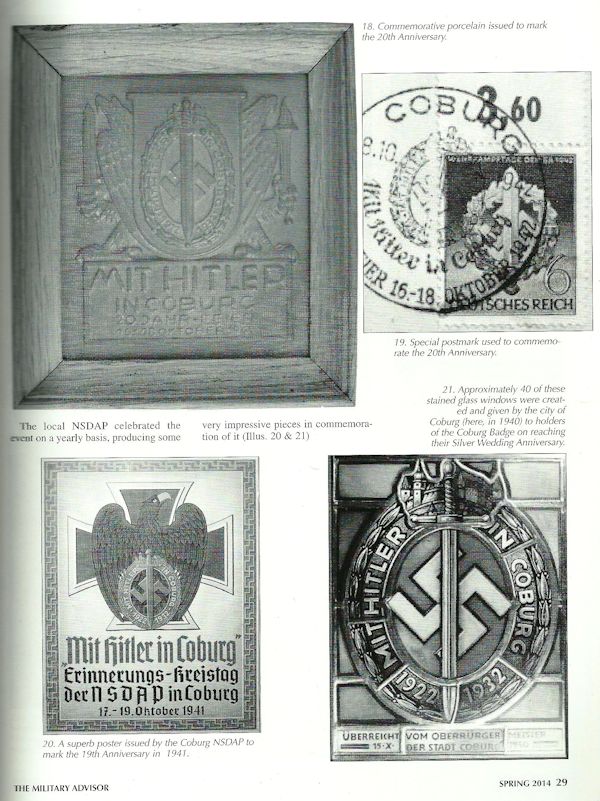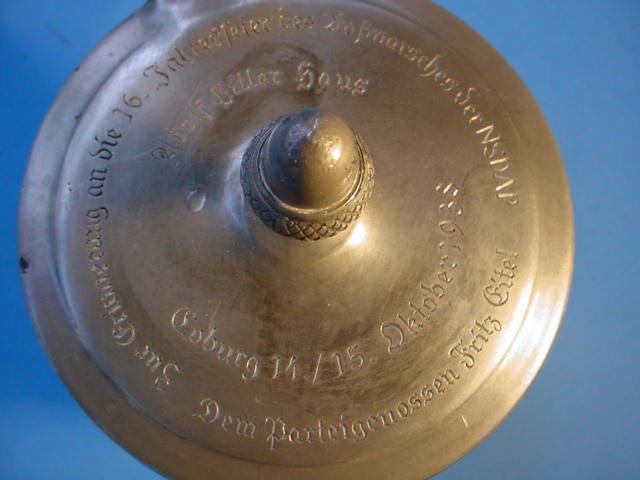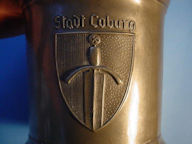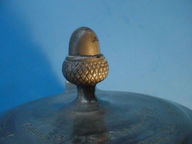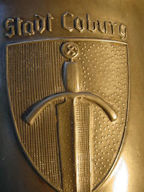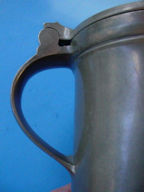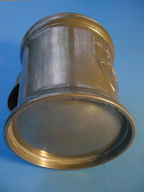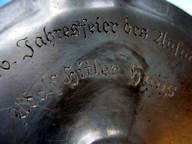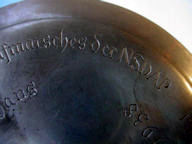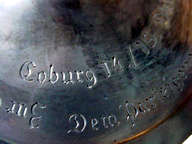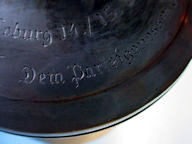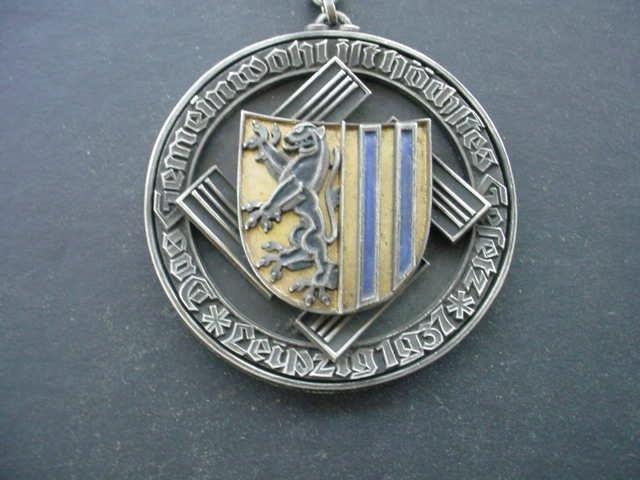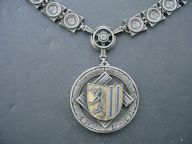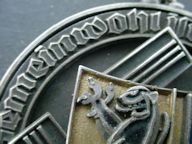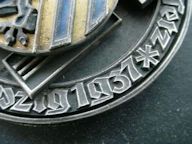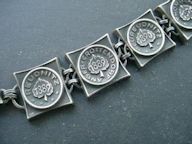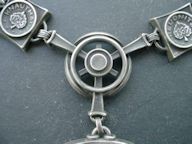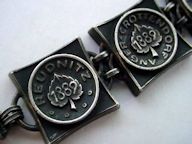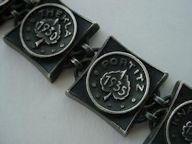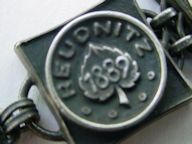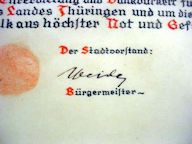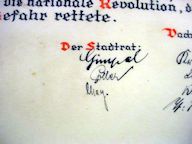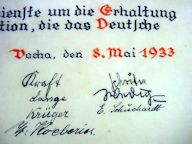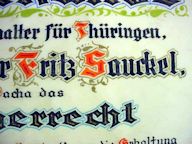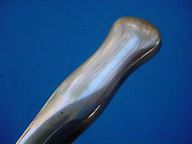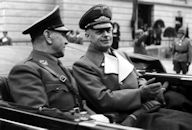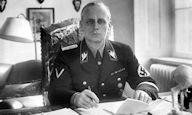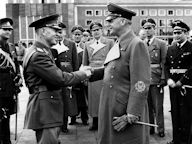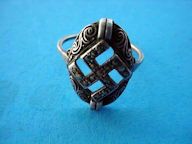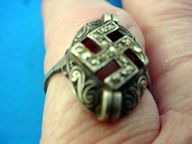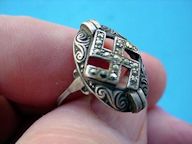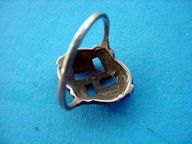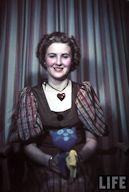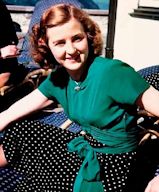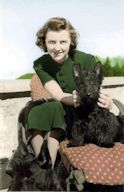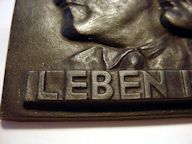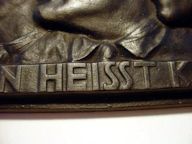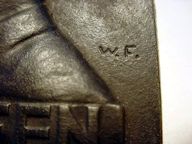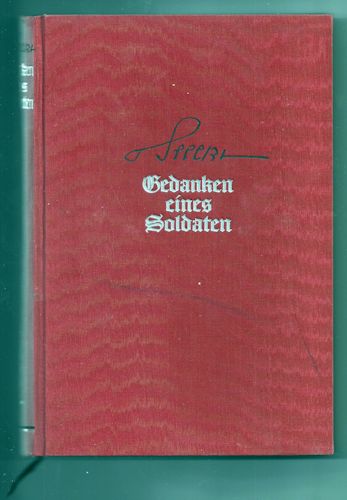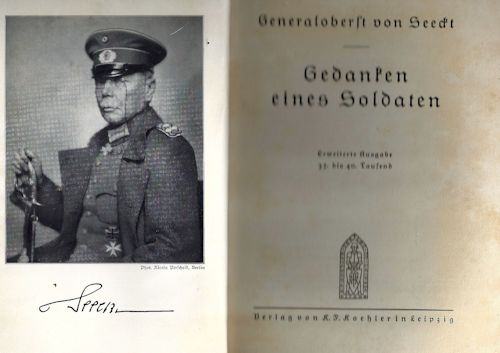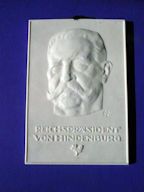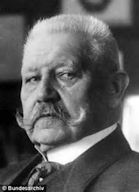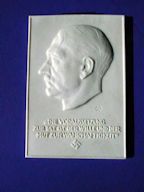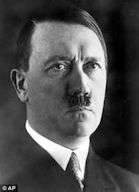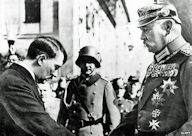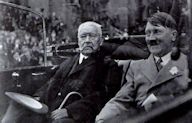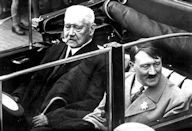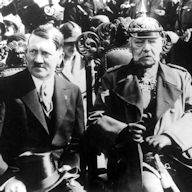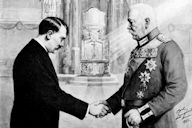|
[ Home Page ]
[ Third Reich ]
[ Old Reich ]
[ Kaiser Reich ]
[ Imperial Russia ]
[ Axis Powers ]
[ Italian Fascist ]
[ WW I ]
[ Landsknecht ]
[ Kaiser Wilhelm ]
[ Frederick the Great ]
Personality Items
Page 5
|
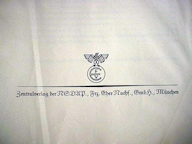
|
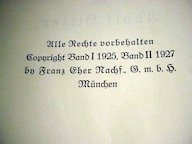
|
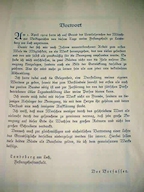
The foreword
|
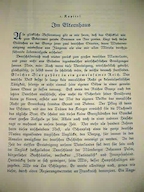
The first page of the contents
|
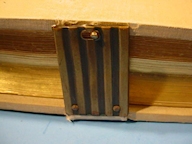
The closing hinges
|
|
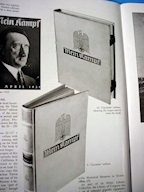
The article in the "Military Trader"
|
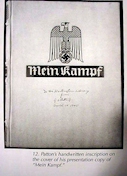
General Patton's gift
|
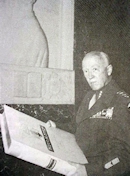
Patton presents the book.
|
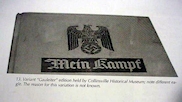
|

The article in Life
|
|

Life
|
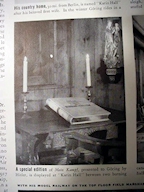
The Göring copy
|
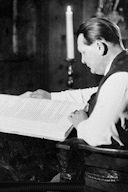
Reichsmarshal Göring reads passages out of his giant Mein Kampf
|
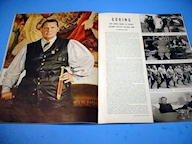
The Göring article
|
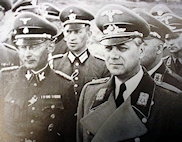
Rosenberg at the Eastern Front
|
|

This was probably the day
of the presentation
|
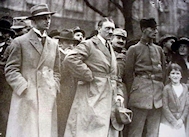
An early-1920s image of Rosenberg on the left
|
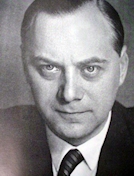
|
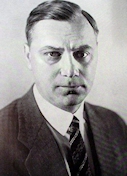
|
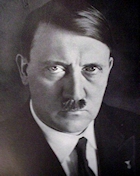
The presenter
|
|
Rare “Gauleiter” Edition of Mein Kampf presented by Adolf Hitler to NS Leader Alfred Rosenberg (Item PERS 5-1; AH 28-1; RAREBOOK 1-5; MEIN KAMPF 1-2)
|
DESCRIPTION: Undoubtedly, this is one of the most luxurious books ever produced in the Third Reich. This is the so-called “Gauleiter” edition of Mein Kampf and is the singular most sought-after book from the period, and whenever one has been found in the past it has invariably brought a very-high price. Production numbers are not known, but the print run is presumably in the 50-edition range; most experts do agree that only 50 were ever produced. The book is an enormous 20 1/2 x 15 3/4 inches and weighs 40 pounds. It’s printed on white vellum with gold top, bottom, and side staining and replete with gold stamping on the front and spine. The book has closure with iron hinges.
One of the most unusual copies of this edition must surely be the copy currently held at the Huntington Library in California. That one is inscribed on its cover and was presented to the library by General George Patton on June 11, 1945, six months before General “Wild Bill” Donovan ordered his OSS team to assassinate Patton in the name of “national security.” Exactly to which Third Reich luminary this copy originally belonged remains unclear. Patton told Huntington officials that one of his units had captured it near Weimar. A later version of its “capture” claimed it was part of Patton’s Berchtesgaden loot, although Berchtesgaden had not yet fallen when Patton signed the book on April 11, 1945. You can see in our image a snapshot of the general as he presents it to the library. Patton surely must have been a strong man; you can see him handling this huge 40-pound book as if it were a dime novel! The book remains in the Huntington Library to this day.
A variant copy of the rare book with a different eagle reposes in the Collinsville Historical Museum in Illinois as part of its library collection. The Library of Congress has a set of unbound, gigantic-lettered signatures. These may have been intended for a Gauleiter edition or for another project altogether? The fact is that there were 50 Gauleiters and Reichsleiters combined, and each received a copy of the book.
One of the most notable examples of one of these books actually being used is the photo that appeared in the September 11, 1939, edition of Life magazine. The picture shows a copy of the book on a special table display between two candles in Hermann Göring’s mansion, Carinhalle. The caption under the picture reads as follows: “A special edition of Mein Kampf presented to Göring by Hitler is displayed at ‘Karin Hall’ between two burning candles with a [statuette of Madonna] nearby.”*1
It is for sure that all of the copies were presented personally by Adolf Hitler or directly under his official auspices.
This leads us to relate to you that the one in our possession was presented to none other than Alfred Rosenberg, the National Socialist ideologue and brilliant writer. Perhaps no other Reichsleiter of NS Germany deserved this honor more than this remarkable man and literary genius. Inside the cover there is a dedication page (see image). The inscription reads: “To my faithful collaborator, Alfred Rosenberg, in recognition of his special services to Germany's cultural renewal, I dedicate this. The Author.” (vom Verfasser),and we all know who the author is!
No Third Reich book could possibly be considered as utterly rare or important as this edition of the words of Adolf Hitler and, considering the importance of this man, Alfred Rosenberg. This is a museum piece of extraordinary value vastly exceeding the reasonable price we have set upon it.
Alfred Ernst Rosenberg (12 January 1893–16 October 1946) was an early and intellectually influential member of the National Socialist Party. Alfred Ernst Rosenberg was first introduced to Adolf Hitler by Dietrich Eckart the brilliant playwright and the man referred to as Hitler’s mentor. Rosenberg later held several important posts in the N.S. government. He is considered one of the main authors of key National Socialist ideological creeds; including its racial theory, Lebensraum; abrogation of the Treaty of Versailles; and opposition to what the NS party considers degenerate modern art, as do I. He is also known for his rejection of orthodox Christianity as it is practiced and interpreted. He played an important role in the development of Positive Christianity, which he intended to be transitional to a new revised faith.
At the star-chamber Nuremberg trials he was tried, convicted, and sentenced to death—as so many Christian martyrs have been in the past—and executed as a war criminal vis–à–vis Joan of Arc. This trial was notorious because almost all of the indictments were decreed and charged by ex post facto law. In other words, laws that never existed before and were suddenly invented to fit the murder exercises joined by the tribunal with the express purpose of bending to the murder lust of the victors with most of them knowing that their own countrymen had committed far greater crimes on a much larger scale in the war; especially the Soviets. In the case of Alfred Rosenberg and Julius Streicher they were basically executed (Murdered) because they wrote essays and books that were in modern terminology “politically incorrect.”
But, Germany was defeated and the war’s victors were free and anxious to murder anyone for any reason whatever, while dutifully obeying orders from those whom Queen Victoria’s colorful prime minister, Disraeli, had earlier and soundly identified as the “Hidden Hand! ” *2
Alfred Rosenberg—German Patriot
Alfred Rosenberg was born to a family of Baltic Germans in 1893 in Revel in Estonia, then part of the Russian Empire. As a young man, he studied architecture and completed his Ph.D studies in 1917. During the Russian Revolution of 1917, he supported the counterrevolutionaries and of course later at the Nuremberg trials this was remembered by the Communist Russians and their fellow allied dupes, and this was later to be a death sentence in and of itself. Following the failure of the resistance movement, he emigrated to Germany in 1918. After arriving in Munich he contributed to Dietrich Eckart’s newspaper the Völkischer Beobachter, and we know he was also greatly influenced by Houston Stewart Chamberlain’s epic book The Foundations of the Nineteenth Century, one of the key proto-NS works of racial hygiene and theory, and at this time his German and Western patriotic ideals led him to become vibrantly anti-Bolshevik.
Rosenberg became one of the earliest members of the German Workers’ Party (Later the National Socialist German Workers Party) joining in January 1919. (Adolf Hitler did not join until October 1919.) Rosenberg had also been a member of the Thule Society with Eckart. He also was a member of the Aufbau Vereinigung reconstruction organization, a conspiratorial association of white-Russian émigrés, which had a critical influence on the National Socialist Party policies. After the failed Beer Hall Putsch, Hitler was sent to Landsberg Prison and Rosenberg was made the leader of the NSDAP, a position he held until Hitler’s release. In 1929, Rosenberg founded the Militant League for German Culture. He became a Reichstag deputy in 1930 and published his book on racial theories, The Myth of the Twentieth Century, which deals with key issues in the National Socialist ideology such as the “Jewish question.” Rosenberg intended his book to be a sequel to Houston Stewart Chamberlain’s book cited above. The book was a great success and sold over a million copies by 1945 and remarkably sealed his fate. Rosenberg did manage to convince Hitler of the Communist threat that, by the way, is no less a threat today, especially in the United States where the far left is making giant strides toward absolute power because of the total apathy of the American people.
Rosenberg was appointed leader of the NS Party’s foreign political office in 1933, but played little practical part in the role. A visit to Britain that year was designed to reassure the British that the German government would not be a threat, and to encourage what should have been a natural link between two basically Aryan western nations of brothers; however, it was an notable abject failure for that hidden hand that Disraeli spoke of had already cast the fatal decision that Germany had to be destroyed!
Yes, Rosenberg built on the racial works of Arthur de Gobineau, Chamberlain, and the American eugenics of Madison Grant, as well, in addition to the beliefs of the man he held above all others—Adolf Hitler. He did, in fact, promote the Nordic theory which regarded the Germanic peoples as the “Herrenvolk” (The Master Race) * 3 as did our own Madison Grant! Rosenberg also opposed homosexuality and promoted extreme German nationalism just as so many Americans like Ronald Reagan and John Kennedy promoted patriotism for their nation. He rejected “churchology” and the concept of universality for original sin, at least for Germanics, who, he claimed on at least one occasion, were born noble, and, therefore, deserved the immortality of the soul. He believed that certain Christian teachings enfeebled a nation and its people. Following Chamberlain’s ideas, he condemned what he called “Negative Christianity” arguing instead for a Positive Christianity based on Chamberlain’s claim that Jesus was a member of the Indo-European Nordic resident in ancient Galilee, who struggled against Judaism and was compatible with the Nordic sense of the spiritual and the Nordic “blood-soul.” He fervently believed in connecting the individual to his racial nature.
His admiration and support for Martin Luther as a great and holy man of the true church was always very evident in his writings. Luther’s writings were sacrosanct in his estimation. In 1940, Rosenberg was made head of Hohe Schule, the center of national-socialistic ideological and educational research. Within this organization, he created a special task force for music with a mission to collect the best musical instruments and scores for use in a university to be built in Adolf Hitler’s home city of Linz, Austria. Following the invasion of Communist Russia, Rosenberg was appointed head of the Reich Ministry for the liberated eastern territories. He presented to Hitler his plan for the organization of the Eastern territories suggesting the establishment of new administrative districts to replace the previously Soviet controlled territories; this would be accomplished with new Reichkommissariat. Such suggestions were to encourage certain non-Communist nationalism and to promote Germanic interests for the benefit of future Aryan Generations in accord with the Geopolitical Lebensraum im Osten plans. They would provide a buffer against Soviet expansion in preparation for the total eradication of Communism and Bolshevism by decisive preemptive military action.
As NS Germany’s chief racial theorist, Rosenberg considered Slavs to be basically Aryan. He often complained to Himmler about the treatment of the occupied peoples. Because the invasion of the Soviet Union intended to bring about the New Order, German propaganda efforts designed to win over the Russian peoples were rather patchy and inconsistent. Alfred Rosenberg was one of the few among the NS hierarchy who advocated a policy designed to encourage anti-Communist actions and opinions. Amongst other measures Rosenberg issued a series of posters announcing the end of the Soviet Collective farms (kolkhoz). He also issued in 1942 an agrarian law annulling all Soviet legislation on farming, thus restoring the family farms that the people had held for generations.
There were numerous German armed forces posters asking for assistance in the “Bandenkrieg,” the war against the Soviet partisans who were murdering in the most gruesome manner German soldiers, and Russian farmers who cooperated with the Germans. Of course, Rosenberg at the star-chamber trials at Nuremberg was accused of carrying on an effective campaign against these vermin as if this was not necessary and militarily a sound decision. Certainly, again and again, the Germans were held to a very different standard of dispensing justice in warfare than the victors who performed in the same manner and most cases far more strict measures were applied. Rosenberg was captured by allied troops at the end of the war. He was tried at Nuremberg and, not surprisingly, found guilty of conspiracy to commit crimes against peace, planning and initiating and waging wars of aggression, and war crimes and crimes against humanity. All of these charges as we have pointed out earlier were classic examples of ex post facto law: laws that were especially construed and tailored by the tribunal and never were used in any legal precedent before. Throughout the trial it was agreed by the black-robed so-called judges that Rosenberg had a decisive role in shaping National Socialist philosophy and ideology and his book The Myth of the Twentieth Century was introduced into evidence constantly as if writing a book and having an opinion should be tantamount to the issue of a death sentence. His stated opposition to the horrid Versailles Treaty also seemed to be an indictment against him.
So, this brilliant man, a man apart, a destiny marcher, would now leave a grieving widow (Hedwig) and a beautiful little daughter (Irene) after being condemned to death and executed in a horribly gruesome manner by a tribunal of vastly inferior men and now would meet the rope of the American monster hangman Sgt. John Woods, who is rather busy at the moment being slowly turned on a spit in hell, while Alfred Rosenberg is busy writing more masterpieces in Walhalla!
Credit for photos and part of the text to Jeff Hanson who wrote a brilliant concise history of the various Mein Kampf variations published in the "Military Trader Journal" in 2008.
NO LONGER AVAILABLE
*1 Göring’s home in the Schorfheide forest in East Prussia was in the German spelling (“Carinhalle”) not “Karin Hall.”
*2 Benjamin Disraeli said: “Governments do not govern, but merely control the machinery of government being themselves controlled by the “Hidden Hand.” (He certainly could speak with believable authority, because he was a member of that particular evil group.)
*3 Rosenberg once said: “Racial history is therefore natural history and the mysticism of the soul at one and the same time; but the history of the religion of the blood conversely is the great world story of the rise and downfall of peoples, their heroes, and thinkers, their inventors and artists.”
|
|

Note for size perspective the relationship to my arm |
|
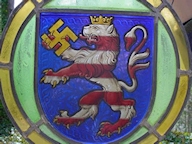
|
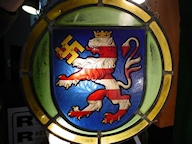
|
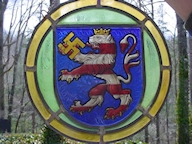
|
<

The modern Thüringen crest;
not nearly as brave as ours
|
|

Gauleiter Fritz Wächtler
|
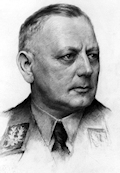
Gauleiter Fritz Wächtler; educator, NSDAP official
|
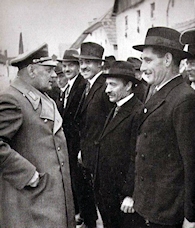
Wächtler with local teachers
|
|
Stained-Glass Thüringen Lion Window Hanging Having Belonged to NSDAP Gauleiter Fritz Wächtler (Item PERS 5-2; ART 17-16a; NSD 20-10)
|
DESCRIPTION: Stained-glass art goes back more than a thousand years. The name for this particular piece is Opalescent window art and actually it was originally an ancient art form from Munich and usually depicted religious themes. In Germany, a stained-glass window hanging as we offer here would be referred to as a Buntglas Fenster. Many years ago, Mr. Johnston, our historical advisor, lived in New York and was engaged for many years in the procurement and sales of war relics. He always had “the best”! There came a time that he approached a veteran or the vet approached him and told him that he had two ’Nazi’ stained-glass windows and was willing to sell them and several other items he had brought back (looted) from Germany. It turned out that from extrapolation of some letters and postcards that he said he took from the same estate that it was then loomed evident after subsequent research that here revealed was the Gauleiter of eastern Bavaria of Gau Bayreuth and that all the items were from his former office or home and that region. Wächtler also held the honorary rank of  -Obergruppenführer and Reich Defense Commissioner of Bayreuth. He had originally trained as a primary-school teacher and had the great honor bestowed upon him of being appointed the head of the Socialist Teachers League NSLB in 1935. He proved to be an able organizer and after the death of the first Gauleiter of the Bayreuth area, Hans Schemm, who died in an airplane crash, Wächtler was appointed his successor and until 1938 also served as the mayor of Bayreuth. -Obergruppenführer and Reich Defense Commissioner of Bayreuth. He had originally trained as a primary-school teacher and had the great honor bestowed upon him of being appointed the head of the Socialist Teachers League NSLB in 1935. He proved to be an able organizer and after the death of the first Gauleiter of the Bayreuth area, Hans Schemm, who died in an airplane crash, Wächtler was appointed his successor and until 1938 also served as the mayor of Bayreuth.
The glass window hanging
This magnificent piece of the glaser’s art depicts the arms of Thüringen. We wondered about this as Bayreuth was his official home and his workplace. Why Thüringen? Then it came to us! Wächtler was born in 1891, in Triebes Thüringen and it would have been understandably nostalgic to have this beautiful reminder of his ‘Heimat’ in his personal window. After joining the Nazi Party as member 35,313 in April 1926, he became its founding local group leader in his hometown of Triebes. He was elected as a member of the Bavarian Landtag and appointed deputy Gauleiter for the district of Thuringia. From August 1932, Wächtler served as education minister in the cabinet of the Minister President of Thüringen Fritz Saukel. Following the 1933 victory of the NSDAP until December 1935, Wächtler held the post of interior Minister of Thuringia and he also became a member of the Reichstag in Berlin. There is a controversy over his death. Some internet blogs say he was executed on the orders of Martin Bormann because he left the city of Bayreuth with his staff as American tanks approached. Bormann had ordered that all Gauleiters, Kreisleiters, and other NSDAP political leaders were to fight to the death in their districts. With the city in ruins and only 200 irregular defenders left, Wächtler left and set up offices in Waldmünchen in the southern part of the Gau. Some say he was executed by his own deputy, Ludwig Ruckdeschel, on orders from Bormann (Cause: desertion). Later evidence provides the more likely story that he was killed in an American bombing raid that followed. When Mr. Johnston bought this beautiful stained-glass window, hanging there actually was another one with it and that one was very impressive as well with the Coburg Honor Badge as its central design. This badge shows a Teutonic sword that has a background of a golden swastika and around its edges it says “Mit Hitler in Coburg 1922-1932” and at the bottom it says: “Presented by the Lord Mayor of the city of Coburg 1946 – Uberreicht vom Oberrugermeister der Stadt Coburg 1945” At the top of the badge partially covered by the grip of the sword is a depiction of the Coburg castle. This Thüringen window hanging is probably the prettiest piece we have ever offered and it speaks volumes about Germanic majesty and Third Reich history. The lion in the crest looks proud and ready for combat as he holds the Hakenkreuz (swastika) and he wears the crown of the old Thüringen kingdom. Compare him against the rather effeminate coat of arms of the modern Thüringen state and it’s probably fitting that that cowardly lion is surrounded by eight “Stars of David.” After the war, Thüringen officials in the former Third Reich administration were replaced by Communists, released criminals, sex offenders, and far-left goons in 1945, and the present administrators are the sons and daughters of these malfeasants. So, dear collectors, here is one of the finest relics of another civilization destroyed by the ‘Kulturträger’ (Bringers of culture)! Give it a proud home my Germanophile friends, it deserves it.
PRICE: SOLD
|
|
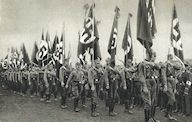
The brown battalions march against the Red terror.
|
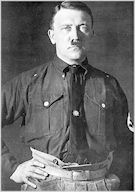
Adolf Hitler in 1922
|

NSDAP delegation in Coburg, 1922
|
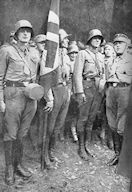
SA--Treue um Treue
|
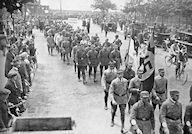
Vorwarts, Vorwarts, die Fahne Hoch!
|
|
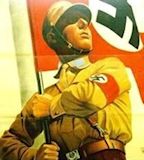
"Die Fahne Hoch!"
|
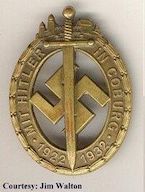
Actual badge the participants wore
|
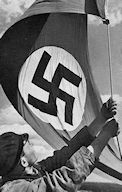
The swastika flag flies over Coburg.
|
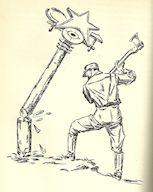
There came a change in old Coburg.
|
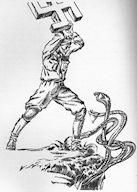
Sieg in Coburg
|
|
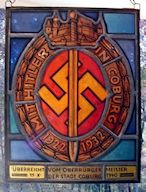
|
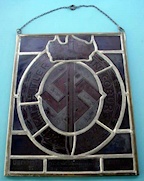
|

|
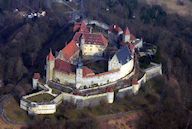
The Veste Coburg, one of Germany's largest castles
|
|

Saxon Gaulieter Martin Mutschmann wearing his Coburg badge
|

Julius Schreck, 1st commander of the SS wearing the Coburg badge
|

Jakob Grimminger, the bearer of the Blood Flag wearing the Coburg badge
|

Gauleiter Fritz Wächtler, right
|

Gauleiter Fritz Wächtler, center
|
|
Serious collectors, the famed Coburg Stained-Glass Window Hanging (Item PERS 5-3; NSD 20-11; ART 17-17)
|
DESCRIPTION: This is the other piece we mentioned in the article above chronicling the Thüringen Lion window hanging from the home or offices of Fritz Wachtler, Gauleiter of eastern Bavaria and Gau Bayreuth (please read the article above, for it relates this glass piece with that lion motif window hanging.) Mr. Johnston my, historical advisor, bought both the Thüringen Lion and the Coburg window hanging together in New York back some 40 years ago. After he sold them he was pretty sure he would never see them again. But, many years later it was brought to his attention that they ended up in the collection of Mr. William Blynn, a noted collector of only the finest and rarest of Third Reich art objects and historically important relics of that era. When Mr. Blynn passed away, all of his collection was turned over to a Connecticut auction house and to our amazement, the two glass items were among the pieces offered up for sale. Thankfully, this auction is little known to collectors of National Socialist items. The auction house’s specialty is signatures/autographs so I was able to procure the Thüringen piece in January 2013, and the Coburg badge piece in September. I paid dearly, but nowhere near the true value of these two wonderful items. There is some legal controversy between me and the auction house and litigation will soon commence (more on that in a separate article rating the auction firms). In the meantime, we believe we have secured two “Holy Grails” of N.S. relics. Hardly anything out there can match the desirability of these matchless treasures--especially the Coburg window. The Blutfahne might have more symbolic meaning and importance, but this piece runs a close second. Not many Third Reich antiques of the faith (N.S. Bewegung) can have more meaning than anything dealing with Coburg and the famous pitched battle that took place there in 1922 between the National Socialists and the Red Front. This is the place where the Nazi movement finally gained the final and full momentum to move assiduously toward the final Machtergreifung in 1933 (the ultimate seizure of power). Coburg was a town which had long been dominated by Marxists and other lowlife leftists, liberals, and their ilk, and it seemed strange that on a Saturday in October 1922, the town was to celebrate a Deutscher Tag (German Day) and even more oddly, Adolf Hitler was actually invited to attend—probably by a lone N.S. sympathizer on the town council. Hitler was asked to come and bring a” few friends”; however, we know that Hitler was an exceptional opportunist and he actually rented an entire train and filled it with 800 followers and even brought a great 42-piece band planning to take the town by storm. It must be remembered that in 1922 Hitler was a mere “nobody” and only his followers and Brown Shirt Storm Troopers thought that anything would come of him. According to public records and testimony of N.S. observers and marchers, the massed townspeople and wide-eyed Jews almost fell out of the express trains as they passed them. Hiring the train was accomplished by every N.S. member involved who bought one or more tickets often with his last Reichsmark. When the National Socialists arrived, a uniformed policeman and a town official told them that they could not march into the city with bands playing and flags flying and those words were music to the ears of Adolf Hitler. He actually pushed aside the policeman and the politician and the N.S. people marched into the town center with swastika flags flying and all the musical instruments blaring. Then it happened!. A crowd of thousands threatened to bar their way. Some of the crowd (fanatical communists) began to throw things (rocks and bottles) and a furious battle erupted lasting about 25 minutes, but in time most of the crowd began to join the Nazis and before long they had won over the towns people and the Reds were soundly bloodied and defeated. Here, at last, the citizens of Coburg and people across the nation envisioned a savior from the communist repression. However, the town officials were not exactly happy. The next day the Nazis triumphantly boarded the train and then Hitler was told that Red railroad-union members would not run the train back to Munich. Again, Hitler saw an opportunity. He told the railroad officials that he and his S.A. troopers would run the train themselves, but they would first kidnap every dirty communist they could find and take them back to Munich on the commandeered train. He made it clear that what would eventually happen to these Red thugs would be left to anyone’s imagination! The communists capitulated. The train ran. Hitler had won and in the minds of patriots at that time, Germany had won. In 1937, Hitler authorized and caused a badge to be struck to memorialize the event that might well be considered the turning point of National Socialism. They had progressed from failure to overnight discovery and immense popularity in the hearts and minds of the German populace. This highly esteemed award was equal in importance with the Blood Order. It was awarded only to the participants of the Coburg confrontation where the swastika won the day. The badge is highly sought after by collectors. It actually was a fairly simple-looking badge struck in bronze that shows the Coburg fortress at its top. This is the largest surviving medieval fortress in Germany famed for sheltering Martin Luther during the Diet of Augsburg. The oldest part of the castle (the blue tower) was built in 1230. In 1550, Martin Luther lived in the “Veste Coburg” for five and a half months. He stayed for the duration of the Diet of Augsburg, which he could not attend as he was considered an outlaw against the Holy Roman Empire much like Adolf Hitler was in the eyes of the postwar Weimar republic. Luther had worked on his German translation of the bible here and wrote no less than 22 works on reformation issues. So, you can see that the town of Coburg was important to at least two earth-shattering events. No wonder it was a much-coveted award to the March participants then and to collectors today and that is precisely why the bidding went high in the auction for this badge immortalized in stained glass. Thank goodness the auction house was not better known or the piece would have brought a price of ‘epic proportions.’ Many noted collectors knew of this piece for many years and will now be amazed that it is now available.
The Window hanging (Fenster Hängen)
The badge shown bears the legend ”MIT HITLER IN COBURG 1922-1932” and under the badge is seen in three panels the words ”ÜBERREICHT VOM OBERBÜRGERMEISTER DER STADT COBURG 15 x 1940.” The article shows that excellence of the art of Durchschientbilder. In no land is the art of stained-glass window hangings more practiced and perfected than in Germany. We have said that these pieces were from the home or office of Gauleiter Fritz Wachtler, who was also an  Gruppenführer. The translation of the words on the panels refer to the presentation of the panel by the Lord Mayor of the city of Coburg in 1940. The mayor of that grateful community wanted to present the highest and most prestigious gift imaginable to the Gaulieter. What do you give to a man who has everything? Well, give him what he doesn’t have! This undoubtedly was the greatest gift of all considering all the implications and spiritual mythos to the N.S. movement. We have offered the greatest and most historically important items in the past and present by far, and our customers say greater than any other militaria site, but we can readily say without any circumlocution that this may be the Zenith. Many other great relics actually fade in significance to this incredible and awe-inspiring relic of the Reich. It is without a doubt, magnificent, beautiful, and at the same time in a word “Overwhelming!”
By Paul Poole, General Manager, Germania International
Gruppenführer. The translation of the words on the panels refer to the presentation of the panel by the Lord Mayor of the city of Coburg in 1940. The mayor of that grateful community wanted to present the highest and most prestigious gift imaginable to the Gaulieter. What do you give to a man who has everything? Well, give him what he doesn’t have! This undoubtedly was the greatest gift of all considering all the implications and spiritual mythos to the N.S. movement. We have offered the greatest and most historically important items in the past and present by far, and our customers say greater than any other militaria site, but we can readily say without any circumlocution that this may be the Zenith. Many other great relics actually fade in significance to this incredible and awe-inspiring relic of the Reich. It is without a doubt, magnificent, beautiful, and at the same time in a word “Overwhelming!”
By Paul Poole, General Manager, Germania International
PRICE: $20,000.00
In the spring issue of Military Advisor, Vol. 25, Number 2, writer and historian Jeff Hanson wrote a brilliant 10-page article on the history of the event called: “At Coburg I made History.” These were the words of Adolf Hitler in remembering the famed victory of his party on October 14/15, 1922. On page 29 of the magazine article among some other historic Coburg items he shows a picture of the Coburg memorial window and claims 40 were created and presented to holders of the Coburg Badge on reaching their Silver Wedding Anniversary. We do know Fritz Wächtler received this one, but who else? If only 40 were given, only one has ever been found since the end of the war, and given the composition of the piece and the intense hate and vilification of the denazification officials after the Reich’s surrender it is doubtful that any other one will ever surface.
Below you will see one of the pages of that beautifully researched and presented article written by Mr. Hanson that appeared in the Military Advisor we referred to above. Here you can see the picture of the Coburg memorial window at the bottom right of the page. In the article there were pictures of Gaulieter Fritz Wächtler with Adolf Hitler. Wächtler was the man who was behind the promotion of the Coburg celebrations and the raising a memorial monument in the town of Coburg . He also was said to be the associate designer of the finished badge that was so prestigiously important in the Reich. The original Entwurf, or draft, for it however, was drawn up by Adolf Hitler, himself.
|
|
| 
|

|

Here was the Adolf Hitler Haus as mentioned in the above article
|
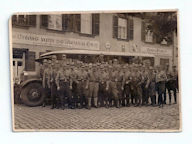
SA men getting ready for the Coburg march
|
|
|
Coburg Presentation Beer Stein Given to a Blood Order Recipient (Item PERS 5-4; ART 17-17b; NSD 18-16a)
|
| DESCRIPTION: This finely crafted pewter beer mug with lid was presented to a member of the Blood Order, one of 1,500 members of the NSDAP who participated in the abortive “Beer Hall Putsch” of November 9, 1923. The 6½-inch-tall mug bears an emblem on its front of a sword with mobile swastika pommel; this is a representation of the Coburg Badge and is surmounted by the wording “Stadt Coburg.” The lid bears a representation of an acorn and around this is engraved: “Zur Erinnerung an die 16. Jahresfeier des Aufmarsches der NSDAP. 1938 Dem Parteigenossen Fritz Eitel. Adolf Hitler Haus – Coburg 14./15. Oktober." [Presented at the] Adolf Hitler House in Coburg 14/15 October 1938 to party member Fritz Eitel in memory of the sixteenth anniversary of the march of the NSDAP.” The stein is in fine condition with two original photos; one shows SA-Stormtroopers lined up in front of a Biergarten probably in Coburg since it came with the stein; the other is a picture of the Hitler Haus mentioned on the top of the stein. The SA men are standing in front of a bus and if you read the story of the famed march, you will know that the SA came to Coburg on buses and trains. This mug celebrates trooper Eitel’s reunion with his fellow Stormtroopers to commemorate a weekend rally held in Coburg on 14 and 15 October 1938. The event was held at the building known as the “Hitler Haus.” The town was considered sacred to the NSDAP. After the incident covered in the description, the stained-glass window hanging above the town was visited by Hitler and “old fighters” at least fourteen times for commemorative ceremonies known as “German Day” (“Deutsches Tag”). After October 15, Hitler was given the freedom of the city. This stein’s importance cannot be underestimated. The Coburg episode goes down in history as one of the major events that propelled Adolf Hitler to power. His fantastic courage resolved in the event of 1922 endeared him to the German public as the man of action whom they needed to fight back against the Red Front and Reaction. The acorn on the lid is representative of the ancient Yggdrasil, or “World Tree,” sacred to the Teutons and thus featured in many articles of art considered sacrosanct or spiritually important. This stein to the N.S. party member would have obviously been regarded as such.
PRICE: $2,500.00; (a historical treasure!)
|

|
|
|
Signed and Dedicated Picture of the Famed “Sea Devil” (Item PERS 5-20; KRIEG 10-19; WWI 12-25)
|
|
DESCRIPTION: Felix Graf von Luckner (9 June 1881-13 April 1966), sometimes called in English “Count Luckner,” was a German nobleman, naval officer, author, and sailor who earned the epithet “Der Seeteufel” (the Sea-Devil); his crew was known as “Die Piraten des Kaisers (the Emperor’s Pirates). These titles were earned for Luckner’s exploits in command of the sailing commerce raider SMS Seeadler (Sea Eagle) between 1916 and 1917. It was Luckner’s habit of successfully waging war without casualties which made him a hero and a legend on both sides. In the early months of WWI Felix von Luckner saw action at the Battle of Heligoland Bight (1914). At the Battle of Jutland he commanded a gun turret on board the battleship Kronprinz Wilhelm. At the beginning of the war, Germany converted a considerable number of merchant ships into merchant raiders by equipping them with guns and sending them in search of Allied merchant shipping. Most of the armed raiders were not particularly successful, but they did tie up considerable Allied forces in hunting them. By early 1915, most of the armed raiders had been hunted down and sunk or else had run out of fuel and been interned in neutral ports. Hoping to revive commerce raiding, the Imperial German Navy equipped the impounded three-masted British sailing ship Pass of Balmaha (1,571 tons) and equipped her with two 105-mm guns hidden behind hinged gunwales, several machine guns, and two carefully hidden 500 HP auxiliary engines. She was commissioned as the auxiliary cruiser Seeadler (Sea Eagle). As Count Luckner was almost the only officer in the German Navy with extensive experience in large sailing ships, he was appointed to command her. His many hair-raising adventures would fill many books. He was the Teutonic superhero that Jack London would have admired had he been allowed to. There is an international Felix Graf von Luckner Society and you can find them through any of the number of search engines. It was founded in 2004 and it would be great if you would support them. It is an admirable group that celebrates one of Germany’s greatest heroes. The photograph measures 4 x 6 inches. The message written says (translated): “Ships may sink, but Rolf Dieter’s work, never, with greetings from your lieutenant.” Dieter could have been an author or shipbuilder or a fellow naval Kamerad, but at the very least someone whose work was admired by Count Luckner. So here is what could be considered a treasure to those who admire the exploits of this heroic warrior seaman that even the “God of the Sea,” Poseidon himself, would have approved of.
PRICE: $195.00
|
|
| 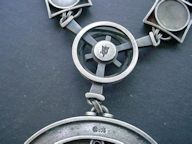
|
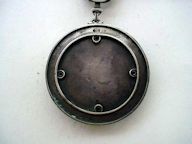
The back of the links
|
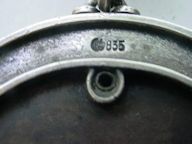
The silver marks
|
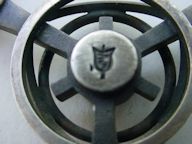
The artist's logo
|
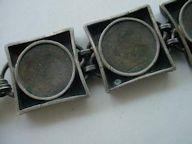
The backside
|
| 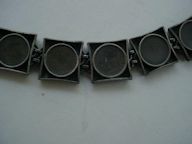
|
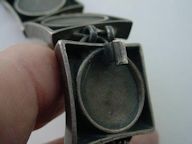
Note stabilizer link for wear on coat
|
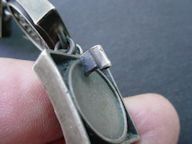
|
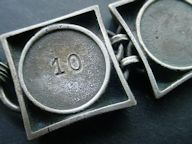
|

The two Leipzig mayors in special Soldiers’ Day celebration
|
|
|
Wonderful Mayor’s Chain from the N.S. era in the City of Leipzig
(Item PERS 5-21; NSD 21-2)
|
| DESCRIPTION: Here is one of the most important pieces of National Socialist paraphernalia that we have ever offered. It’s a Bürgermeister Kette or mayor’s symbol of office. It’s dated 1937, and in that particular year there were actually two mayors that held that post; one was Rudolf Haake who was the Hoch Bürgermeister, and a deputy mayor Kurt Walter Donicke,
who had all the mayoral authority of Haake. In fact they were both highly esteemed leaders and both would have worn a chain of office. One of these chains showed up years ago and was brought back by Mr. R.L. Lawrence of Arlington, Texas. The one we offer is of course one of the two; we don’t know the whereabouts of the present collection. This chain is exquisitely constructed of solid “835” silver and so marked. The links in the chain represent every district by name that came under the authority of the Leipzig Gau Saxon and the year they were incorporated. There are 35 of these links. The central medallion is well marked with the crown, moon, and silver designation of “835” and the three-spoked suspension device is marked with the logo of the silversmith who constructed the chain. The chain weighs an impressive one pound six ounces and is an outstanding subject for further research. The central design is comprised of three separate planchets superimposed over each other. The top one has the black rampant lion of Leipzig with two blue stripes lying upon a golden shield. Under this is the ribbed swastika that is resting upon the circular vortex that has an inscription in raised letters that comes out to read something about the laws and regulations concerning all the municipalities and public welfare. This is a very important piece of German WWII history and a particularly beautiful example of the mastery and superiority of German metallic jewelry artisans. This particular item was designed by famed silvermaster Alfred Schafter. A Bürgermeister was a very prestigious rank in the National Socialist sphere of lawgivers, especially if said mayor was installed in a large metropolitan city like Munich, Berlin, and especially Leipzig, which was a sacred city to the German people for it was here that Napoleon Bonaparte met his greatest defeat in October of 1813; this monumental struggle was called the Battle of Nations because a coalition of the armies of Russia, Prussia, Austria, and Sweden led by Tsar Alexander I of Russia decisively defeated the French Army. The battle was the culmination of the 1813 German campaign and involved over 600,000 soldiers, making it the largest battle in Europe prior to WWI. For the French emperor it was the beginning of the end and as we know, the great Prussian marshal Gebhard von Blücher of Leipzig battle fame along with his “children” (Prussian soldiers) went on to deliver the last knockout blow to Bonaparte at Waterloo June 18, 1815. Without the Marshal Vorwarts Blücher the English would have decidedly lost. So, the German people have long held a deep reverence for their marshal and Leipzig and the Battle of Nations that radically changed history for the better until the bitter end of WWII.
PRICE: $15,000.00
|
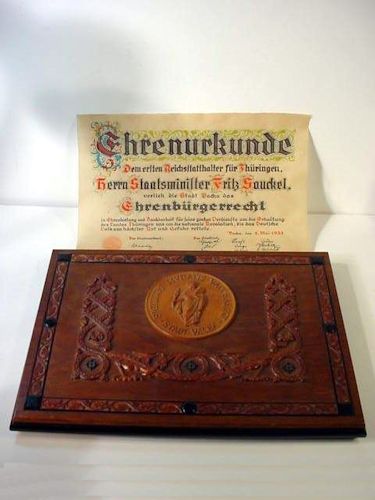
|
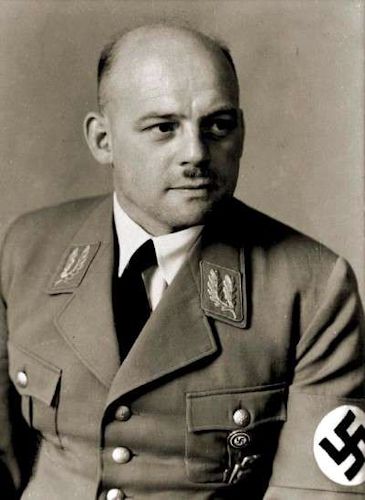
|
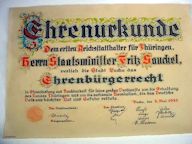
|

|
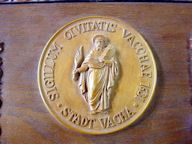
The front plate with town symbol
|
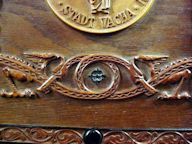
Details of the case trim
|

|
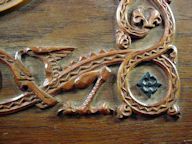
|
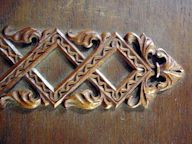
|

Open Case
|

|

Images 25 through 32 show document's wonderful calligraphy and signatures.
|
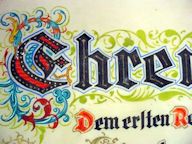
|
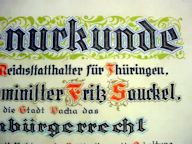
|
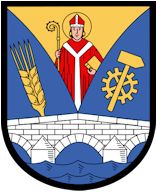
The coat of arms of the town of Vacha
|
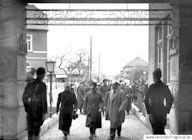
Sauckel arrives at the Gauforum with other N.S. officials
|
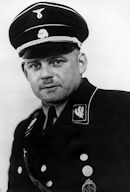
Sauckel in SS uniform
|

Fritz Sauckel, Gauleiter
|

This is the Gauforum that contained Sauckel’s offices
|
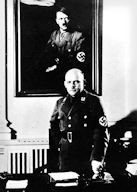
Fritz Sauckel in his office in the Gauforum
|
Honorary Citizenship Bestowed Upon the Minister of State Fritz Sauckel (Ehrenurkunde) (Item PERS 5-22; NSD 21-8)
|
DESCRIPTION: Also referred to as Ehrenburgerrecht--that entitles honorary citizenship. In 1933, Adolf Hitler received literally hundreds of these items making him an honorary citizen of almost every large city and right down to the smallest dorf or burg. As you know, Hitler was born in Austria, but he longed from youth to be a German. Make no mistake the “Ostmark” (Austria) is essentially German, but geographical borders set it apart until the Austrian Anschluss that transpired after Hitler announced it on March 12, 1938. Austria was then officially part of the entity known as (Gross Deutschland) Greater Germany. When Hitler was appointed by Marshal Hindenburg as Reich’s Chancellor in 1933, most of the leftist journalists and numerous reactionary parties issued forth attacks against him and continually uttered the ad nauseam verbiage that accused him of not even being German. They continually rendered the statement that Hitler was not even a German he was an Austrian! It was then that one German city awarded him their honorary citizenship and after this, more than 4,000 towns did the same. They are very rare today and it is a fact that Hitler stored most of the actual certificates at the Berghof and because of an order issued to the  by the Führer, himself, most of them were destroyed along with all his personal possessions left at his Obersalzberg mountain retreat in 1945. The only ones to survive were those that were never sent, but archived in the town halls on display in showcases in the Ehrenzimmers of such buildings. A letter was sent from the high mayor of the town with a picture of the document on display to the offices of the Führer asking if this was acceptable and usually it was. We show one of these that you can see at AH 20-12 and another at AH 21-4. So, it was an established tradition that these grateful municipalities would honor their great leader, thusly. Now! There were also some more of these honorary citizenships that were sometimes bestowed on other National Socialist leaders, but very few have been found, and if ever located they usually are associated with the towns in the districts that the N.S. recipient would be most connected to. We once had one to Herman Göring and it was from the town of Veldenstein, the village that his castle was situated in, and one from Rheydt in the Rhineland to Dr. Joseph Goebbels. This was the town he was born in. Ehrenburgers to N.S. leaders other than Hitler are much more rare, but don’t usually command the prices brought by ones to the Führer. However, another factor in the collector’s value of any of these documents is the amount of fine artwork presented in some of them are extremely elaborate and generally include fantastic calligraphy extraordinaire! No two are ever alike of course but some are artistic masterworks without a doubt! Now, we have fortunately procured a really rare and beautiful one that was dedicated and presented to then minister of the state of Thuringia, Fritz Sauckel. Later, he became the Gauleiter of Thuringia. Ernst Friedrich Christoph “Fritz” Sauckel (27 October 1894-16 October 1946) was a German Nazi politician, Gauleiter and the General Plenipotentiary for Labor Deployment from 1942 until the end of the Second World War. During WW II, he was Reich’s defense commissioner for the Kassel district (Reichsverteidigungskommissar). He was born in Hassfurt (Kingdom of Bavaria), the only child of a postman and a seamstress. Sauckel was educated at local schools and left early when his mother fell ill. He joined the merchant marine of Norway and Sweden when he was 15, first on a Norwegian three-masted schooner, and later on Swedish and German vessels. He went on to sail throughout the world, rising to the rank of Vollmatrose.(master seaman ). At the outbreak of WWI, he was on a German vessel en route Australia when the vessel was captured. He was subsequently interred in France from August 1914 until November 1919. He returned to Germany, found factory work in Schweinfurt, and studied engineering in Ilmenau from 1922 to 1923. He joined the National Socialist German Worker’s party (NSDAP) in 1923 (member number 1395). In 1924 he married Elisabeth Wetzel, with whom he had ten children. He remained a party member over its dissolution and publicly rejoined in 1925. Sauckel was appointed party Gauleiter of Thuringia in in 1927 and became a member of the regional government in 1929. Following Hitler’s appointment as chancellor in 1933, he was promoted to Reich Regent of Thuringia and Reichstag member. He was also given an honorary rank of Obergruppenführer in the SA and the by the Führer, himself, most of them were destroyed along with all his personal possessions left at his Obersalzberg mountain retreat in 1945. The only ones to survive were those that were never sent, but archived in the town halls on display in showcases in the Ehrenzimmers of such buildings. A letter was sent from the high mayor of the town with a picture of the document on display to the offices of the Führer asking if this was acceptable and usually it was. We show one of these that you can see at AH 20-12 and another at AH 21-4. So, it was an established tradition that these grateful municipalities would honor their great leader, thusly. Now! There were also some more of these honorary citizenships that were sometimes bestowed on other National Socialist leaders, but very few have been found, and if ever located they usually are associated with the towns in the districts that the N.S. recipient would be most connected to. We once had one to Herman Göring and it was from the town of Veldenstein, the village that his castle was situated in, and one from Rheydt in the Rhineland to Dr. Joseph Goebbels. This was the town he was born in. Ehrenburgers to N.S. leaders other than Hitler are much more rare, but don’t usually command the prices brought by ones to the Führer. However, another factor in the collector’s value of any of these documents is the amount of fine artwork presented in some of them are extremely elaborate and generally include fantastic calligraphy extraordinaire! No two are ever alike of course but some are artistic masterworks without a doubt! Now, we have fortunately procured a really rare and beautiful one that was dedicated and presented to then minister of the state of Thuringia, Fritz Sauckel. Later, he became the Gauleiter of Thuringia. Ernst Friedrich Christoph “Fritz” Sauckel (27 October 1894-16 October 1946) was a German Nazi politician, Gauleiter and the General Plenipotentiary for Labor Deployment from 1942 until the end of the Second World War. During WW II, he was Reich’s defense commissioner for the Kassel district (Reichsverteidigungskommissar). He was born in Hassfurt (Kingdom of Bavaria), the only child of a postman and a seamstress. Sauckel was educated at local schools and left early when his mother fell ill. He joined the merchant marine of Norway and Sweden when he was 15, first on a Norwegian three-masted schooner, and later on Swedish and German vessels. He went on to sail throughout the world, rising to the rank of Vollmatrose.(master seaman ). At the outbreak of WWI, he was on a German vessel en route Australia when the vessel was captured. He was subsequently interred in France from August 1914 until November 1919. He returned to Germany, found factory work in Schweinfurt, and studied engineering in Ilmenau from 1922 to 1923. He joined the National Socialist German Worker’s party (NSDAP) in 1923 (member number 1395). In 1924 he married Elisabeth Wetzel, with whom he had ten children. He remained a party member over its dissolution and publicly rejoined in 1925. Sauckel was appointed party Gauleiter of Thuringia in in 1927 and became a member of the regional government in 1929. Following Hitler’s appointment as chancellor in 1933, he was promoted to Reich Regent of Thuringia and Reichstag member. He was also given an honorary rank of Obergruppenführer in the SA and the  in 1934. Saukel was arrested after the war and attempted to defend his actions. At the Nuremberg Trials he did not refer to any of the victims as slave laborers. Sauckel argued that the whole process of using laborers was simple economics and he denied that there was any systematic mistreatment of them. “If mistreatment did occur,” he said, “it was the result of rogue guards and local commands.” Writing the sheer scale of what he was trying to achieve this had to be expected and could not be countered. His defense team pointed out that Sauckel had sent out instructions to regional commanders of slave laborers that they should be treated with “adequate care.” Investigation in later years proved this to be for the most part true, but it must be noted that the Nuremberg Trials were nothing but a Star Chamber sham hearing calling itself a war-crimes tribunal. They were so fraudulent that they could not possibly have been held in America since the U.S. (so far) prohibits kangaroo-court tactics with such ex post facto charges and hearsay testimony. Dwight Eisenhower’s brother Edgar, a lawyer, called these Nuremberg “trials” a sham, saying that the trials cannot be justified by any line of reasoning. Supreme Court Chief Justice Harland Fisk Stone stated (while the trials were underway mind you) that the proceedings were a high-grade lynching party and a fraud. When we acknowledge this statement wouldn’t we come to the expectation that something was amiss? The fact is the Nuremberg process in itself was not a judicial process at all! Rather, it was a staged act of vengeance against the defeated, and it was particularly profaned by the fact the Russians with the blood of innocents still dripping from their hands were among the judges and were themselves of course guilty of multitudes of murderous scenarios far beyond the measure of crimes and atrocities that were now leveled at the Germans. Irish author Michel Walsh has written a brilliant synopsis of the trials. So was the indictment by this phony ‘court’ to be considered within law with fairness, and judicial decency? I’ll leave this to you to decide. Fritz Sauckel was probably innocent of all the ex post facto crimes dreamed up by the so-called Tribunal. I think he was a man who came to the fore when his country truly needed him. Enough said? I think so. in 1934. Saukel was arrested after the war and attempted to defend his actions. At the Nuremberg Trials he did not refer to any of the victims as slave laborers. Sauckel argued that the whole process of using laborers was simple economics and he denied that there was any systematic mistreatment of them. “If mistreatment did occur,” he said, “it was the result of rogue guards and local commands.” Writing the sheer scale of what he was trying to achieve this had to be expected and could not be countered. His defense team pointed out that Sauckel had sent out instructions to regional commanders of slave laborers that they should be treated with “adequate care.” Investigation in later years proved this to be for the most part true, but it must be noted that the Nuremberg Trials were nothing but a Star Chamber sham hearing calling itself a war-crimes tribunal. They were so fraudulent that they could not possibly have been held in America since the U.S. (so far) prohibits kangaroo-court tactics with such ex post facto charges and hearsay testimony. Dwight Eisenhower’s brother Edgar, a lawyer, called these Nuremberg “trials” a sham, saying that the trials cannot be justified by any line of reasoning. Supreme Court Chief Justice Harland Fisk Stone stated (while the trials were underway mind you) that the proceedings were a high-grade lynching party and a fraud. When we acknowledge this statement wouldn’t we come to the expectation that something was amiss? The fact is the Nuremberg process in itself was not a judicial process at all! Rather, it was a staged act of vengeance against the defeated, and it was particularly profaned by the fact the Russians with the blood of innocents still dripping from their hands were among the judges and were themselves of course guilty of multitudes of murderous scenarios far beyond the measure of crimes and atrocities that were now leveled at the Germans. Irish author Michel Walsh has written a brilliant synopsis of the trials. So was the indictment by this phony ‘court’ to be considered within law with fairness, and judicial decency? I’ll leave this to you to decide. Fritz Sauckel was probably innocent of all the ex post facto crimes dreamed up by the so-called Tribunal. I think he was a man who came to the fore when his country truly needed him. Enough said? I think so.
The Ehrenbürger
The document itself is inscribed in the finest calligraphy that you can ever envision but the case that it was presented in is quite strikingly beautiful, as well. As I have said, practically all these Ehrenbürgers are unique in their artistic presentation. Usually they imply somewhere within them evidence of the talent of the leading artists of the community or something reminiscent of the cultural traditions or main produce of the citizens of the area. This actual document says in bold lettering “Honorary -certificate to the first Governor for Thüringen.” The state minister Fritz Sauckel receives from the city of Vacha this honorary citizenship. These are the large words and down below this are the smaller words that translate to “in homage and grateful thanks for your great service and the honorable attitude for the land Thüringen in the National revolution on behalf of the people in their great need and in the time of danger you rescued them.” It is signed in hand by the mayor on behalf of the city board of councilors and then by the Stadtrat (city council) who all 10 sign by hand in Vacha on the May 8, 1933. The document measures 14 ½ x 10 inches and is printed in genuine medieval-style parchment and the supplier of this paper who may be the calligrapher as well is signed in tiny letters in the left-bottom corner. The name–Karl Sodemann. If indeed he was the person who did the calligraphy, he was a master of the art.
The Case
The cassette in which the document came cased is another masterpiece of artistic achievement, as well. This work is signed inside under the document’s left-bottom corner as “N. Gelle.” The cover of this case is decorated with a beautiful plaque that depicts Saint Boniface, patron saint of Thuringia, who stands above the words (“City of Vacha”) with a Latin grouping of words seen as Sigillum Civitr Vacchae 1637. (“Seal of the City of Vacha 1637”). The center plaque is surrounded by configurations of Teutonic design featuring dragons and other Nordic patterns and the outer edges have a continuum of leaf-like border. All of this to me looks hand carved from wood but it could be crafted from molds in Bakelite; we just can’t tell but either way the artistic value is both evident and gorgeous! The document is not fastened or glued inside the cassette and I am sure this was facilitated in the event that Sauckel would have wanted it to be framed and placed on the wall of his office in Weimar. This office was in the Gauforum north of the city center in the Adolf Hitler Platz. The city presenting this honorable title upon Fritz Sauckel was the town of Vacha and it is in the Wartburgkreis district in Thüringen, Germany. It is situated on the river Werra within the German empire. Vacha was part of the grand Duchy of Saxe Weimar Eisenach. The town was one of the most loyal to the N.S agenda and principles, thus, the document is indeed a very important article of Third Reich historical treasures.
PRICE: $2,850.00
|
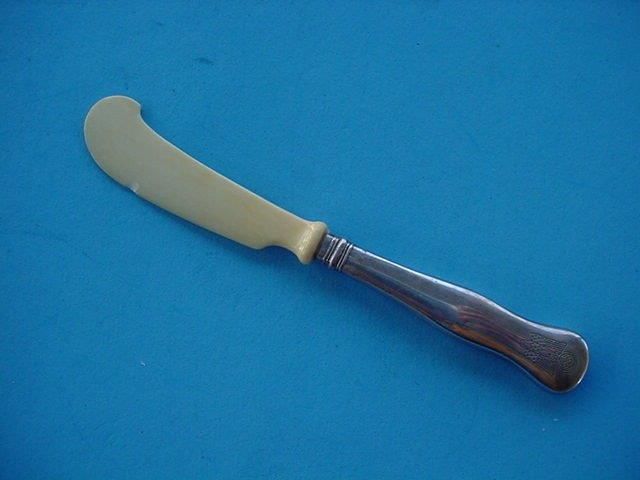
|

|

|

Note the small chip
|
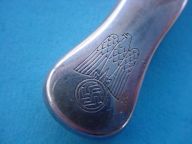
The Ribbentrop special eagle
|
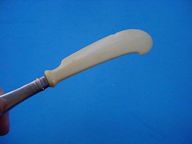
|
Rare Butter Knife from the Estate of Ambassador Joachim von Ribbentrop (Item PERS 5-23; THIRD REICH TABLEWARE 1-30)
|
DESCRIPTION: Here is what we consider a real rarity. This is a butter knife from the property of the murdered N.S. Minister of Foreign Affairs Joachim von Ribbentrop. This rare piece of cutlery probably was used by both Ribbentrop and Adolf Hitler at Foreign Ministry diplomatic dinners or other state function. Joachim was a truly controversial personality wounded and a recipient of the Iron Cross in WWI. He joined the N.S. Party in May 1932. He wore the N.S. Golden Party badge. He was the ambassador to England from 1936-1938. It was he who negotiated the treaty with Russia in 1943. Hitler stated: “He is greater than Bismarck.” He certainly knew his trade. He was a handsome man with great ability yet soft spoken and the complete gentleman at all times. He saw the necessity of a German crusade against Bolshevism as did all clear-thinking N.S. leaders. In the end of the tragic war he was judged to be executed by the ogre “Judges” presiding at the Nuremberg trials. These charges were as we know today as ipso facto—created right there at the trial and never would have stood up in postwar times in any civilized nation on earth. A similar case might be a U.S. president making an executive decision without approval of Congress. Sound familiar?
The Butter Knife
The piece measures at about 6 ½ inches long with the handle or grip measuring about 3 ½ inches. The blade is formed from a piece of ivory-looking material which may be celluloid. The grip is of genuine silver. The engraved eagle on the grip is distinctive of the one shown on page 110 in the book The Encyclopedia of Third Reich Tableware by James A. Yannes. Much of the information seen here in our narrative is quoted from that book. It’s very informative on a subject rarely addressed in print. This is truly a rare piece of tableware and an important collectable.
PRICE: SOLD
|

|

Eva at the Obersalzberg. Could the ring you see be . . . the ring?
|
|
|
Eva Braun? High-Dress Swastika Finger Ring (Item PERS 5-24; AH 28-26)
|
DESCRIPTION: This elegant ring was purchased by our German picker in Berlin and he bought it from an old gentleman who said he was a former SS member who was assigned to the Führerbunker in 1945. He was a radio operator in the communications room in those last days and hours. He claims that he received this ring from another SS officer who was in the bodyguard regiment. known as the SS-Leibstandarte Adolf Hitler, who received it directly from Hitler’s devoted mistress and longtime companion Eva Braun, who became the Hitler’s wife on April 29, 1945. The L.A.H. guards were, for the most part, treated by the Führer and Eva as members of the family. When Eva knew what her fate would be soon after the marriage the 33-year-old maiden soon to be Frau Hitler began giving many of her personal possessions away to people she admired and considered dear friends such as these devoted, loyal, SS guards and other functionaries that shared the bunker. The items were for the greatest part small trinkets and even some incidentals such as a compact case and bits of jewelry, etc. She had come by automobile from Munich to be with Hitler at the Führerbunker and she brought only two small suitcases and two handbags. She refused to leave as the Red Army fiends closed in. In our opinion, the ring we offer certainly has the look of something Eva would wear; however, we only have the word of the elderly radio operator for it. My experience with these men in the past dealings with them has really convinced me that truthfulness has always been their most obvious criteria. As for the word of our picker, his ever-dependable honesty we are ever confident of. He has for three decades been correct and reliable in his dealing with us. So, although we cannot offer any provenance with the ring, we ourselves are quite satisfied with the historical declaration as given to us. However, without some provenance that we can otherwise provide we feel that the item should be valued pricewise as if it had such provenance.
The Ring
The ring was probably presented to the L.A.H. bodyguard by Fr. Braun with compliments to the man’s wife who undoubtedly would have received it, but then that SS officer gave it to the SS radioman. Why? We do not know; neither did the man that it was bought from. The ring is quite stunning with a studded Hakenkreuz (swastika) in its center with silver support fittings with floral design. The studs that make up the swastika are in my estimation a form of cut-metal pyrites cut to look like diamonds and they do indeed! They shine with a gorgeous brilliance. The fact that they are not diamonds is founded in the historical fact and truism that Hitler and the National Socialists highly distained both gold and diamonds because the party mythos dictated that these items were considered to be the favored monetary symbolsof the Jewish race. So, it follows that Eva would not flaunt diamonds and it also follows that the ring is in silver instead of gold and that fact is also historically noted. The ring is in size 6 3/4 (petite). We know many gifts were presented to her by practically every important guest to the Obersalzberg, Hitler’s retreat in the Bavarian Alps where she lived in the happier days. So, we would assume that one of these honored visitors in all probability had given it to her. So, my collecting friends, yes, purchasing it will be an act of faith but that’s what motivated us and we feel quite good about it. Let’s say: “Everything fits and is virtually quite rational in the historical recitation.”
PRICE: SOLD
|
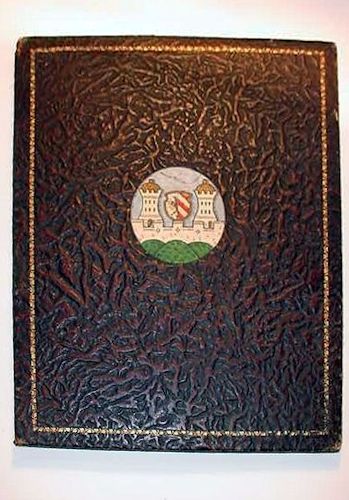
|
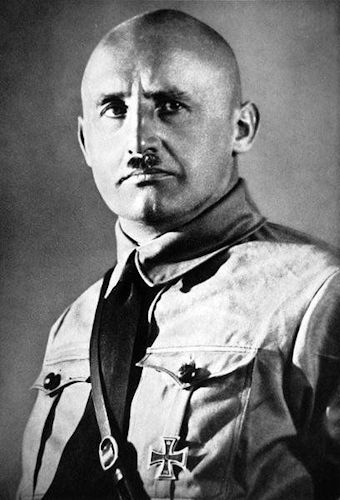
*Not included in offering
|
| 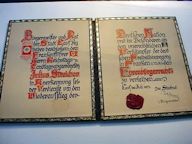
|

|
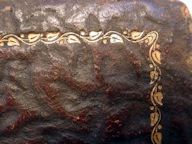
|
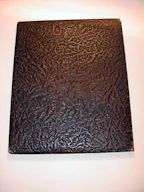
The back cover
|
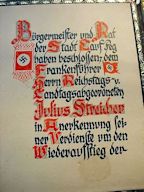
The document’s left side
|
| 
The document’s right side
|
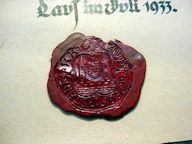
The wax seal is, amazingly, intact.
|
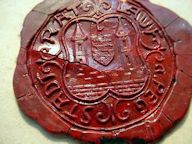
|

|
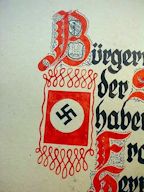
|
| 
|
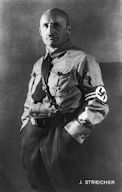
*Not included in offering
|

*Not included in offering
|
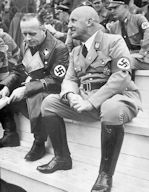
*Not included in offering
|

*Not included in offering
|
|
|
Julius Streicher is Given an Honorary Citizenship (Item PERS 5-25; NSD 21-11)
|
DESCRIPTION: As you can see in some of the write-ups above, these honorary citizenships (Ehrenurkunde) were presented to Hitler by the thousands and to his NSDAP leaders by the dozens. Please read about the one given to Fritz Sauckel at PERS 5-22, above. In its first few lines is a good explanation of the usage and meaning of these Ehrenurkunden. They are highly sought after by collectors and historians. The Hitler ones are by no means common, but let’s say that there are numerically more of them even though no two are ever alike and all are treasures in their own right. Over the years we have had several Hitler examples; however, to find one presented to other high NSDAP leaders is much more a task. I would have to say that finding one to Julius Streicher would have been to my thinking impossible, but here it is! And we are most proud and pleased to offer it at this time. Streicher is the most disparaged and denounced man of the Third Reich era. He is maligned, reviled, and thoroughly assailed by, well, I think you know who. At one time he was a prominent member and leader of the NSDAP. Prior to WWII he was the founder and publisher of Der Stürmer newspaper which became an element of the N.S. propaganda machine. He also published three anti-Semitic books for children including the 1938 editions of The Poison Mushroom. For this Streicher was one of eleven German leaders who went to their deaths on the gallows at Nuremberg inn October 1946. Streicher alone died solely for his speeches and writings. He wasn’t part of the German government during the war; weren’t these proceedings called the “war crimes trials?.” Yes, it could be and was said that the books, speeches, and other writings were basically horrid. But when the Charlie Hebdo people were massacred in Paris for spreading cartoons and vicious hateful, propaganda on January 27, 2015, the world cried about those people, didn’t it ? But to be officially strangled to death for similar activity this more than anything else goes far to prove that the Nuremberg Trials were nothing but revengeful witch-hunt trials. This German patriot fought all through WWI winning the Iron Cross and was promoted to the rank of lieutenant. This was not an insignificant achievement. Was he rude and crude? Well, I’d say “yes,” but he believed the particular times called for some of this. To him it was a war and he waged it as such, but it was a word of words! Streicher heard Hitler speak in Munich. This experience left him deeply moved and he joined the fledgling National Socialist Party in 1921, and from that moment on he became a loyal and devoted follower of Hitler. He stood with Hitler in the failed Beer Hall Putsch. It was an act that the Führer always remembered. Streicher was seen by Hitler as a man who had been willing to die for the movement and he became a member of Hitler’s inner circle; something that many top party officials could not claim. While Streicher made enemies in the constant infighting that was a common theme in the senior ranks of the party, he could always rely on the protection of the Führer. From 1925 to 1933, Hitler rewarded Streicher’s loyalty by appointing him Gauleiter of Franconia. Ironically, some senior party officials rather loathed Streicher’s Der Stürmer because they considered it crude. Men like Hermann Göring wanted the world to see N.S. Germany as the pinnacle of culture and refinement and these rough proclamations just did not fit in with this. So, in essence, Streicher was virtually an outcast with the party and as we have stated never was part of the government during the war. There is much material about him on the web—90 percent of it negative—and although he might have been a good fellow to have a beer with in a Munich pub he was an agitator personified. Maybe he was unpolished, but he stood for his beliefs and died with and for them. He was an ardent admirer of Martin Luther and he verbally quoted the great reformer many times expressing Luther when he stood before the court of the Diet of Worms in 1521: “Here I stand, I cannot do otherwise. God help me I cannot do otherwise” Voltaire, considered one of France’s greatest enlightenment writers, said: “I disapprove of what you have to say, but I will defend to the death your right to say it.” This is an iconic belief of the Western World or we hope it is. Joan of Arc was burned at the stake because she would not recant, and Julius Streicher was hanged with no chance to recant, but of course, we also know that he absolutely would not have done so. The horrors that were inflicted on this man before he was hanged were unbelievably abominable. His last earthly words were “I am now by God my father! Adele, my dear wife.” Streicher died after 14 minutes of strangulation. I would suggest that you should look at the various information on the web; pro and con!
The Ehrenurkunde
This honorary citizenship is a very impressive hand-painted document from the city of Lauf an der Pegnitz and dated July 1933. It is signed by the Bürgermeister and confers honorary citizenship in the town that lies just east of Nuremberg. It says: “The Bürgermeister and officials of the city of Lauf an der Pegnitz have bestowed upon the leader of Gau Franken Julius Streicher in recognition of his services as a tireless follower for the German nation and the leader in the German Freedom movement in Franken this honorary citizenship. Lauf im July 1933.” Signed for the city officials by the High Mayor. The town’s official seal in wax is affixed at the bottom. The calligraphy is beautiful and superb with a small hand-drawn swastika banner and flag. The two sides of the document are mounted between the covers of a brown-leather folder with gilt oak-leaf trim inside and outside. The front cover bears a hand-painted depiction of the town’s crest. It’s in nice condition. Closed, the cover measures 12 x 9 ½ inches. Yes, we here at Germania often deal in true rarities, but this particular and fantastically rare item will be recognized by the true historian or very professional collector to be one of the ultimate historically important finds of the year. Controversial? Yes, absolutely! Ultrarare? Yes! Important? Absolutely, yes! Don’t hesitate; make it yours.
PRICE: $3,800.00
|
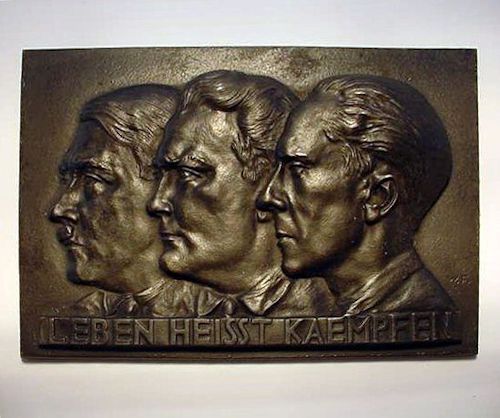
Front
|
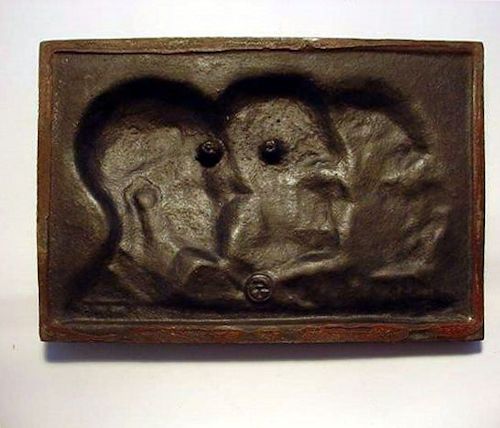
Back
|
|
|
Iron Plaque with Three National Socialist Leaders (Item PERS 5-26; GOR 11-11; GOEBBELS 4-4; AH 29-5)
|
| DESCRIPTION: Here is a plaque crafted in iron rather than the usual bronze. Why? Because it fits the mythos of the “Iron Time.” This can be said to be an important signature of this cultural group that represented the last attempt to revisit the “Imperium” of the West—the greatness of Imperial Rome and the civilized concepts of ancient Greece. Here now was the Aryan revitalization of the Old World brought forward with the “Neuen Reich” for European civilization that probably was the “Widerstand” against the Bolshevik plague whose tentacles now unfortunately embrace our world of political correctness. Here we see the profiles of three men who were instrumental in working toward that goal; three men that history in a future state most likely be highly respected. There, I said it and I stand for it!!! The iron plaque measures 6 x 3 ½ inches. The figures are in a relief-motif depiction (standing right out there as did those three men Hitler, Göring, Goebbels, and the saying under their likenesses is “Leben Heisst Kaempfen.” This can be translated as “Life is a struggle” or “Life is a fight.” Either way, it is a true saying that is befitting of each of these men who working so desperately and diligently for their German nation and for the west only to be betrayed; smashed down by those that should have been their allies. This is not only a rare plaque, but the words are not lost and certainly rather prophetic for our future. I believe Donald Trump has said as Hitler proclaimed that he wants to make his country great again! Let’s hope there will be one more chance! Have I strayed too far from political correctness with my observations? Well, Winston Churchill said, "History will be kind to me for I intend to write it.” The plaque is in fine condition except for the fact that the hanging devise on the back is missing. It has the initials “W.F.” by Goebbel’s shoulder. These are the initials of the artist. This is a great portrayal of past greatness and heroism.
PRICE: $650.00
|
| 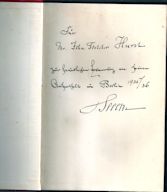
Book signed to his friend, Fletcher Hurst
|
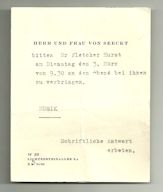
Invitation to a social evening at the von Seeckt estate
|
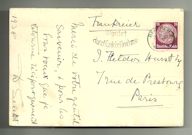
Postcard sent to Fletcher Hurst in Paris
|
|
|
Generaloberst “Hans” von Seeckt: Various Ephemera (Item PERS 5-27; RAREBBOOK 2-5; WWI 13-5; WEHR 33-26)
|
DESCRIPTION: Johannes Friedrich “Hans” von Seeckt (April 1866-December 1936) was an important historical personage and German military officer noted for his organization of the German Army (Reichswehr) during the Weimer Republic. He was a thorough aristocrat. He joined the army in 1885 at the age of 18 and served in the elite Kaiser Alexander Guard Grenadiers and then joined the Prussian General Staff in 1897 at the outbreak of the First World War. Seeckt held the rank of colonel and served as chief of staff in the Third Army Corps. Seeckt marched with the corps in the WWI German offensive and distinguished himself in fighting near Soissons, then in March 1915, he became chief of staff to General von Mackensen of the German Eleventh Army. Seeckt fought in the Gorlice-Tarnów Offensive, where he was credited with engineering Mackensen’s breakthrough and he received the Pour le Mérite, Prussia’s highest military honor. In June 1915, Seeckt was promoted to the rank of general-major and on 1 September he became chief of staff for the Austro-Hungarian Seventh Army in Galicia.
Reichswehr
After the end of the war and the dissolution of the old Imperial Army it fell to Seeckt to organize the new Reichswehr within the strict restrictions composed by the Treaty of Versailles. He successfully laid the basis for a strong Reichswehr and disguised the new leadership effectively with the forbidden general staff, under the name the Truppenamt, or Troop Office. He is also known for this hostile attitude towards the Second Polish Republic, and he was all for seeking an alliance with the Soviet Union against Poland. After seeing encouraging signs from the newly established War Commissar’s Office of Leon Trotsky, Seeckt sent out members of a secret staff to conduct a military alliance with the Soviets, unbeknownst to the Weimar government. After the Allies sent the German government a list of “war criminals” to be tried, Seeckt called a conference of staff officers and department heads on February 9, 1920, and said to them that if the German government refused or was unable to reject the Allied demands, the Reichswehr must oppose this by all means even if this meant the reopening of hostilities! He further said that if the Allies invaded Germany—he believed they would not—then the German army in the West should retire behind the Weser and the Elbe, as this was where defensive positions had already been built. In the East, German troops would invade Poland and attempt to establish contacts with the Soviet Union, wherein they would both march against France and Britain. He added that German war material would now no longer be sold or destroyed and that the army should be refused on paper only. An interior minister of Prussia, Albert Grzesinski, wrote that members of Seeck’s staff said that Seeckt desired a military dictatorship, perhaps headed by Gustav Noske. Seeckt’s role during the Kapp Putsch of March 1920, remains uncertain; he refused to either actively put down the rebellion or cooperate with it. His remark to the leaders of the republic, that “Reichswehr do not fire on Reichswehr”, was controversial. From 1920 to 1926, Seeckt held the position of Chef der Heeresleitung—in fact if not in name, commander of the army of the new Weimar Republic Reichswehr. He was working to build a nonpolitical professional army as a state within a state. He was an admirer of the British concept of a small, highly trained, regular army within which political activity was forbidden. This matched the conditions of the Versailles Treaty which was aimed at creating a long-term, professional army with a ceiling of 100,000 volunteers and without significant reserve; a force which would not be able to challenge the much larger French Army. Seeckt was a monarchist by personal inclination who encouraged the retention of traditional links with the old Imperial Army. With this purpose he designated individual companies and squadrons of the new Reichswehr as the direct successors of particular regiments of the emperor’s army. After Seeckt had met Adolf Hitler for the first time on March 11, 1923, he wrote: “We were as one in our aim; only our paths were different.” However, he firmly resisted Hitler’s Putsch on November 8-9, 1923, insisting that the Bavarian Division of the Reichswehr remain loyal to the Republic. He strongly opposed the Locarno Treaties, which he viewed as appeasement of France and was skeptical of German membership in the League of Nations because he thought it was selling out to West Germany’s connections with Russia. Seeckt was eventually forced to resign on October 9, 1926, after permitting Prince Wilhelm, the grandson of the former emperor, to attend army maneuvers in the uniform of the old Imperial First Guards without first seeking government approval. While running the military, von Seeckt only allowed skilled men to be in the 100,000-man army. He locked them into a mandatory 12 years of confirmed military service with full board and pay, allowing for a stability that rarely existed in the midst of massive economic depression of Germany. He gained the loyalty of his men by paying them six times the amount of a French soldier. Von Seeckt made the training standards of the Reichswehr the toughest in the world. He trained them in antiair and antitank battles by creating wooden weapons and staging mock battles under the guise of training the soldiers for reintroduction into civilian life. Von Seeckt disciplined this small army much differently than past German armies. Rather than beat or shoot a soldier for infractions, von Seeckt forced minor offenders to spend off-hour duties lying under a bed and singing old Lutheran hymns. The chief also had his men taught in seemingly useless topics like horse anatomy and the art of beekeeping to allow them to be citizens with skills as well as military support crews. Later Years: From 1930 to 1932, Seeckt sat in the Reichstag as a member of the DVP, after failing to be adopted as a candidate for the Centre Party. In the presidential election of 1932, he wrote his sister, urging her to vote for Hitler. From 1934 to 1935, he served as an adviser to Chiang Kai-shek. However, on returning to Germany from China he became disillusioned with Hitler. Contained in this offering is a book by Hans von Seeckt entitled Gedanken eines Soldaten (Thoughts of a Soldier). It comprises 157 pages of text with a nice picture of the author on the first page. It’s in almost mint condition and measures 6 ¼ x 9 inches. The book is dedicated in the first inner page to Mr. John Fletcher Hurst commemorating a meeting in Berlin in 1932, and again in 1936, signed by hand in ink by von Seeckt. Also, there is an invitation for the Fletcher family to visit the von Seeckt home at 9:30 in the evening on a Tuesday in March and we assume this was the 1936 meeting when the book was presented. The formal visit was requested by both Herr and Frau von Seeckt. There is a noted music reference. There is also a postcard that pictures some eighteenth-century Chinese artifacts and it is sent with postal cancellation to Mr. J. Fletcher Hurst in Paris. Seeckt wrote in French to Hurst and thanks him for a certain souvenir and he dates it 1935 and hand signs it. Why do I spend so much time and effort to present this particular group of ephemera? Because this old and noble Prussian monarchist was the very epitome of the spirit of Frederick the Great, Blucher, Scharnhorst, et al. When one looks at him with his monocle staring back, you can almost hear the refrain of Deutschland, Deutschland über alles.
PRICE: $385.00; Price for the group
|
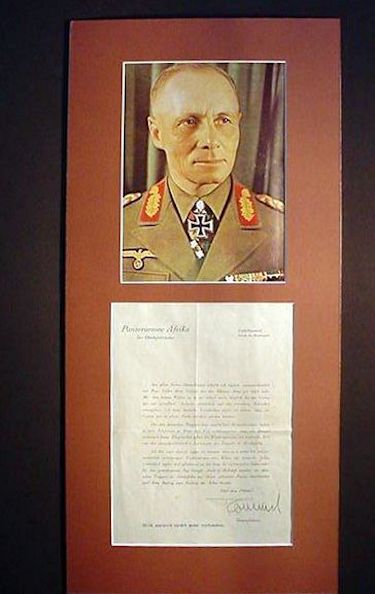
|
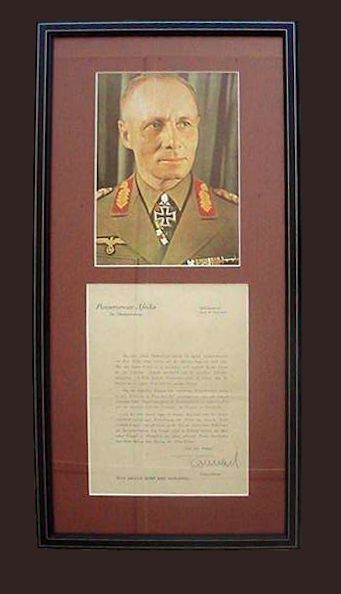
Letter in frame
|
| 
Note the Panzer Army heading
|
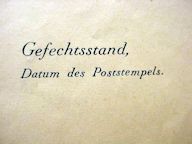
|

Body of the letter
|
| 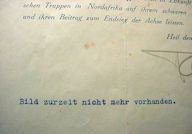
|
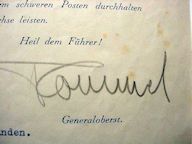
Original Rommel signature
|
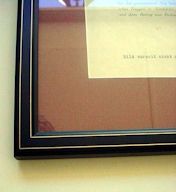
Detail of frame
|
| 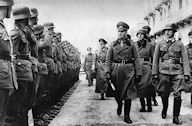
This picture not offered with the framed signature
|
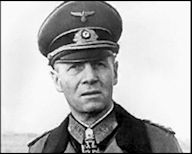
This picture not offered with the framed signature
|

This picture not offered with the framed signature
|
|
|
Signature of Field Marshal Erwin Rommel on Panzerarmee Afrika Stationary (Item PERS 5-28; WEHR 34-1; AFRICA 1-23)
|
| DESCRIPTION: Here is a great Erwin Rommel letter and signature. Here was the most-famed German WWII leader whose valiant Africa Corps threw back repeated British and American assaults in North Africa. Later, he commanded the German troops at Normandy. He was said to be involved in the Hitler bomb plot of 1944, but very probably, he was not. The information we continually see on this comes from the “court historians” so therefore it is shady and dodgy, at the minimum. Rommel was loyal to Adolf Hitler and the National Socialist movement. Most Wehrmacht generals were never members of the Party, but Rommel certainly was and was proud to be. He had connections to the Hitler Youth movement as well. He was a patriotic German and thus he felt it was his duty to affiliate with the political apparatus of his country and he felt this to be the right direction for Europe in those crucial times. He was one of the most beloved officers to the thinking and the hearts of the German people. Even in today’s liberal Germany where traitors are lauded and heroes vilified, the name Rommel is respected and even revered. This document is an 8 x 11-inch form letter that is signed in hand by Generaloberst Rommel. The message is printed on official stationary headed with the words “Panzerarmee Afrika Der Oberbefelshaber.” The subject is a letter to all of his supporters and admirers thanking them for their letters. In part, it reads: “. . . from all parts of Germany I receive daily an extraordinary amount of mail. With the best of intentions, it is not possible for me to personally handle the magnitude of the task of answering each letter. I ask, therefore, for your understanding that your greetings can be answered in this form. In newsreels, you will find a striking picture of the unusual service given by the troops in North Africa. I am proud to say that even under extremely difficult desert conditions, the German soldier fights bravely and dutifully alongside our Italian comrades for our common victory. In the future, the German troops in North Africa will preserve in their heavy efforts and contribute to the final victory of the Axis.” The letter is boldly signed at the conclusion in pencil. There are folds and slight foxing and chipping at the folded-over left edge; otherwise, it’s in very good condition and nicely framed with a stunning picture of the “Desert Fox.” Rommel's signatures are extremely rare.
PRICE: SOLD
|

Poor lighting. Plaques are actually white as snow.
|
|
|
Hitler & Hindenburg in the Form of Two Rosenthal Plaques (Item PERS 5-29; AH 29-9)
|
| DESCRIPTION: Here are two magnificent plaques by the famed porcelain firm of Rosenthal, one of the greatest of the German firms specializing in the very finest of dinnerware, but also it excelled in the manufacture of figural pieces—man and beast. Philip Rosenthal began business in 1884 and initially he purchased white porcelain ware from the company Hutschenreuther during the latter part of 1934. The Rosenthal family came under significant pressure from the growth of German Nationalism (the NSDAP), which ultimately led to the family Rosenthal's having no participation in the management of the company and it was for all practical purposes taken over by the N.S. Party which also controlled the Allach porcelain firm through the SS. After the war, Philip Jr. returned to Germany in an attempt to reclaim family assets and control of the company. Philip Sr. had died in 1937, and at that time, the family emigrated abroad. A settlement with Phillip Jr. was achieved in September of 1950. At no point in their history did the Rosenthal products ever lose their perfection and elegance. Even today Rosenthal products are considered the absolute finest in the field—beauty and perfection of the very best! The Rosenthal mark always signified experience of over 132 years of company history. During the time of the Third Reich, the Rosenthal’s outdid themselves by artistically producing items depicting historical figures such as Marshal and Reich President von Hindenburg and Chancellor Adolf Hitler. You can see another fine Hitler plaque by Rosenthal on this page at item number 21. The two plaques we now offer are small, but fantastic. They both measure 4 ¾ x 3 inches and they are just slightly under a quarter-inch thick. One is a depiction of Paul von Hindenburg, Germany’s heroic marshal in WWI. It’s a magnificent portrayal and reflects the man’s inner strength and his determination to serve his beloved nation. His title—“Reichspräsident von Hindenburg”—and a simple acorn are shown under the bust portrait. On the back can be seen the Rosenthal full logo and shows this was produced at its offices in the city of Selb. The other portrait plaque is of Adolf Hitler, Führer of National Socialist Germany. The perfect likeness is nothing short of astounding and like the Hindenburg portrait, it stands out from the background in beautiful relief. Under the bust figure of Hitler are the words „Die Voraussetzung zur Tat ist der Wille und der Mut zur Wahrhattigkeit.“ Roughly translated this means: “The prerequisite to act is the will and the courage to speak the truth.” If only a few of our politicians of today would act in that way (wishful thinking!). Under these words is a small swastika. The plaques are prodigiously important historically and even more desirable because they are from the world-famous Rosenthal porcelain works in Selb, in the district of Wunsiedel, in Upper Franconia. Most of the N.S.-related porcelain objects were produced there and the town itself was one of the districts fiercely loyal to the N.S. Party concepts. In the town of Wunsiedel was the cemetery where Rudolph Hess was buried and in recent years the beautiful tombstone was removed at the order of the leftist mayor of the town and then later the same ignoramus had the body exhumed, cremated, and the ashes scattered at sea. The hate generated by these Neo-Bolshevik freaks knows no bounds. *Author’s opinion.
PRICE: $950.00; the set of two wonderful pieces
|
Page SixA Very Special Entry! One of the greatest historical treasures
we have ever had the pleasure of offering.
You have to see this one! CLICK HERE! |
Contact Us
Please refer to item designator in parentheses in all correspondence.
Please E-mail for any additional information you may need.
If you prefer, contact 'Germania' at PO Box 68, Lakemont, GA 30552
or call at 706.782.1668 or 706.782.4398.
Please! do not call during the wee hours of the morning. The best time for calling us is between 10 and 11 am and between 9 and 11 pm eastern time.
|
| | |




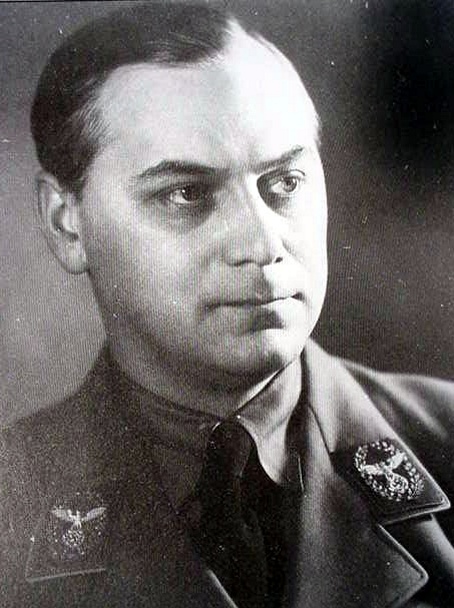
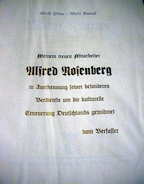
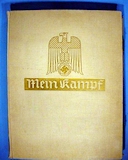


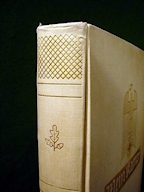




























 -Obergruppenführer and Reich Defense Commissioner of Bayreuth. He had originally trained as a primary-school teacher and had the great honor bestowed upon him of being appointed the head of the Socialist Teachers League NSLB in 1935. He proved to be an able organizer and after the death of the first Gauleiter of the Bayreuth area, Hans Schemm, who died in an airplane crash, Wächtler was appointed his successor and until 1938 also served as the mayor of Bayreuth.
-Obergruppenführer and Reich Defense Commissioner of Bayreuth. He had originally trained as a primary-school teacher and had the great honor bestowed upon him of being appointed the head of the Socialist Teachers League NSLB in 1935. He proved to be an able organizer and after the death of the first Gauleiter of the Bayreuth area, Hans Schemm, who died in an airplane crash, Wächtler was appointed his successor and until 1938 also served as the mayor of Bayreuth. 




















